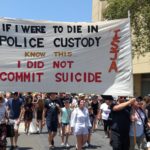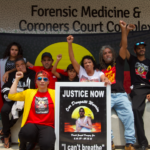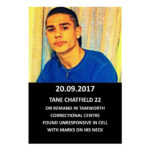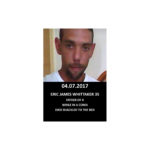Suspicious Circumstances: Patrick Fisher Fell to His Death Whilst Pursued by Police

Released on 23 August last year, the findings of the Inquest into the death of Patrick Fisher set out that the 31-year-old Wakka Wakka man died as a “result of multiple injuries he received when he fell from a 13th floor balcony”.
And while the methamphetamine the father-of-three had been taking contributed to the circumstances of his death on 7 February 2018, the NSW deputy state coroner made clear that it was not a cause of it.
However, Mr Fisher’s family and their supporters are far from happy with the outcome of the inquest, as it fails to acknowledge that a significant contributor that led to Patrick falling to his death, were the five police officers trying to gain access to the apartment he was in.
So, while much of the discussion in the report revolves around Patrick having “slipped while he was trying to climb to the balcony below to avoid being arrested” by attending officers, this point doesn’t factor into the coroner’s final summation as to why the death occurred.
Indeed, the report makes no judgement about the way police approached the situation on the day, even though it was wide open for the coroner to make recommendations as to how officers might have handled the situation differently.
Nowhere to run
“It’s not the correct story,” said Indigenous Social Justice Association (ISJA) secretary Raul Bassi. “They’d been looking for Patrick even when they didn’t have any warrants. They went to the unit the week before to confirm that he was there. When the warrants came, they were trying to get him.”
“There were police at the bottom of the building looking at what he was doing,” Bassi continued. “They were in communication with the police on level 13. The police got into the unit and went straight for him. They never tried to stop to speak with him.”
According to the report, police were tipped off about Mr Fisher being at his girlfriend’s 13th floor apartment in the Sir Joseph Banks Building on George Street in the inner city suburb of Waterloo. And this resulted in five officers knocking and kicking at the unit door trying to gain access.
When the apartment’s occupant opened the door and informed officers that Mr Fisher was on the balcony, NSW police sergeant Ross Veltman rushed over to the open door, stepped outside onto the balcony and later testified to having seen Mr Fisher on the ground below.
“One of the big criticisms at the coronial inquest was that the police didn’t do anything to calm the situation,” Bassi told Sydney Criminal Lawyers. And the coronial report also reveals that police were well aware of Fisher’s habit of trying to escape being taken into custody.
One side of the story
Although, Mr Fisher hadn’t been placed under arrest or been detained at the time of his death, his passing is still considered a death in custody as it falls under the broader definition of such a death as set out by the Royal Commission into Aboriginal deaths in custody.
Recommendation 6 of the commission report outlines the circumstances that are to be considered a death in custody.
These include deaths that occur while in prison, police or juvenile detention, deaths resulting from traumatic injuries sustained while in custody, fatal injuries that occur whilst in the process of police or prison guards trying to take someone into custody, and deadly injuries that happen whilst a person is trying to escape custody.
However, as Mr Bassi stresses, while Mr Fisher’s fall was investigated as a death in custody, and the NSW Coroner’s Court deliberated upon the role police played during the incident, no suggestions were made as to how police could have prevented the fatality from occurring.
The rights activist further points out that it’s clear the police could have waited out the front of the building for Mr Fisher to leave, rather than trying to apprehend a man who was trapped in an apartment high above the pavement and prone to evading police.
NSW deputy state coroner Carmel Forbes asserted that it was “conceded by all parties that containing the building and waiting for Mr Fisher to leave were not realistic” options. But, Mr Bassi refutes that idea, stating that this was only the opinion of authorities.
And it’s for these reasons that at this point, the Fisher family and their supporters are looking into options as to how justice can still be sought. At present, there’s a group working with the family looking into how further legal proceedings might be undertaken.
Ending deaths in custody
ISJA and Fighting in Resistance Equally (FIRE) are running the Blak Deaths in Custody (BDIC) campaign with the aim of bringing about changes to the way NSW authorities are handling these situations.
Of course, the late 80s/early 90s Royal Commission was supposed to bring about changes to the number of deaths inside. But, while it recommended arrest and imprisonment be used as sanctions of last resort when it comes to First Nations peoples, these suggestions have not come to fruition.
When the inquiry handed down its final report in 1991, 14 percent of the Australian adult prisoner population was made up of Indigenous peoples, but almost three decades on that figure has risen to 28 percent. And there’s also been over 400 Aboriginal deaths in custody in that time.
Mr Bassi explained that key reforms BDIC is pushing for include bringing a halt to the targeting of Aboriginal kids as part of the Suspect Target Management Plan, holding police accountable for their actions, and officers who stand by as others perpetrate crimes should be deemed accessories.
“Eighty percent of Aboriginal people charged are remanded. Of white people arrested, only 20 percent go on remand. Why the difference?”, Mr Bassi asked.
And the long-term activist added that the disproportionate remanding of First Nations people must end, “because if they’re not in gaol, they have a better chance of surviving”.







